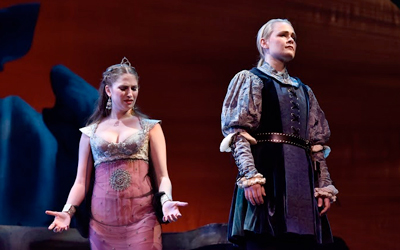by Daniel Hathaway

Probably nobody goes to hear a Handel opera for the story line, but here’s the gist: Alcina is a sorceress who lures heroes to her enchanted island and transforms them into objects or other life forms — flowers in the case of Jonathon Fields’ Oberlin production. Ruggiero, a Crusader, is the latest to be floralized. His fiancée Bradamante comes looking for him, accompanied by her guardian Melisso. At the court, they meet Oberto, a young page who is searching for his father.
The plot thickens as Morgana, Alcina’s sister, falls for Bradamante, making her own sweetheart Oronto jealous. (Oh, by the way, Ruggiero is sung by a women and Bradamante is pretending to be a man, so you can imagine how things get mixed up.) Ruggiero and Bradamante finally extricate themselves from the nefarious powers of the twisted sisters, restoring all those flowers back to human beings. General rejoicing.
Except for the opening and closing choruses, all of this action is related through a long string of da capo arias, vocal forms that begin with an “A” section, move on to a contrasting “B” section, then repeat the “A” section. The format gives singers both the opportunity and license to festoon the original music with elaborate ornamentation and flights of fancy the second time it comes around. That’s what Handel’s audiences came to hear, and the composer gave them a lot of lovely music to enjoy during the course of the 2-½ hour show — and much of that twice.

While Handel didn’t give him a lot of action to draw on, director Jonathon Field staged the arias imaginatively. He created a highly amusing scene when Alcina’s transformed suitors were first revealed. Changed into flowers, they poked heads and arms out of garish cutouts as if Puritans had shamed them by putting them into the stocks. And he staged the scene where Morgana falls for Bradamante as a hilarious caricature of someone suddenly turned delirious with love. Jean-Francois Revon’s fantastically colorful sets were brilliantly lighted by Jeremy K. Benjamin, and Chris Flaharty’s generally-ancient period costumes resonated perfectly.
In the pit, conductor Christopher Larkin drew consistently stylish playing from the Oberlin Chamber Orchestra. After many similarly scored arias, it was a breath of fresh air to hear — late in the second act — one aria with a fine cello obbligato (Angelique Montes) and another that featured two horns (Logan Bryck and Helen Fleischer). Albert Bellefeuille provided attentive harpsichord underlay for recitatives.
Finally freed from their flowery impediments, the chorus brought the show to a triumphal conclusion with their lively singing and dancing. After such a slew of da capo arias, a change in musical style was both needed and welcome.
Photos by Yevhen Gulenko.
Published on ClevelandClassical.com March 22, 2016.
Click here for a printable copy of this article



